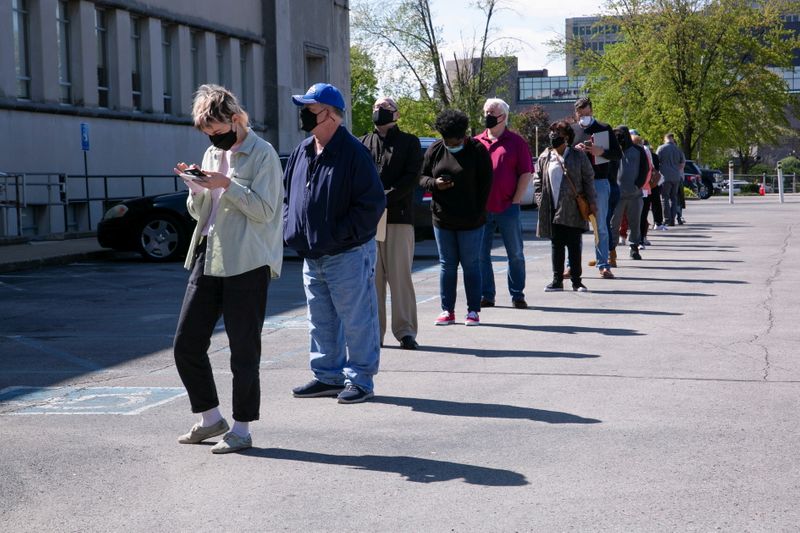By Lucia Mutikani
WASHINGTON (Reuters) - The number of Americans filing new claims for unemployment benefits dropped to a 19-month low last week, pointing to a tightening labor market, though a shortage of workers could keep the pace of hiring moderate in October.
The weekly unemployment claims report from the Labor Department on Thursday, the most timely data on the economy's health, also showed unemployment rolls shrinking significantly early this month. There is cautious optimism that the expiration of federal government-funded benefits on Sept. 6 will broaden the pool of labor in the coming months.
"Hiring demands remain robust, and the short supply of potential workers should make employers think twice about cutting payrolls," said Jim Baird, chief investment officer at Plante Moran Financial Advisors in Kalamazoo, Michigan.
Initial claims for state unemployment benefits fell 6,000 to a seasonally adjusted 290,000 for the week ended Oct. 16, the lowest level since the middle of March in 2020, when the nation was in the early stage of the COVID-19 pandemic.
It was also the second straight week that claims remained below 300,000 as employers hold on to workers in the face of an acute labor shortage. Economists polled by Reuters had forecast 300,000 claims for the latest week.
Unadjusted claims, which economists say offer a better read of the labor market, tumbled 24,293 to 256,304 last week. A jump of 17,570 in filings in California was offset by notable declines in Virginia, Michigan, Pennsylvania, Texas, New York, Kentucky and the District of Columbia.
Claims have declined from a record high of 6.149 million in early April 2020. A 250,000-300,000 range for claims is seen as consistent with a healthy labor market. The number of people continuing to receive benefits after an initial week of aid dropped 122,000 to 2.481 million in the week ended Oct. 9. That was also the lowest level since the middle of March in 2020.
Stocks on Wall Street were mixed. The dollar was steady against a basket of currencies. U.S. Treasury prices fell.
The pandemic has upended labor market dynamics, leading to a staggering 10.4 million job openings as of the end of August even as about 7.7 million people were officially unemployed in September. A range of factors has been blamed for the disconnect, including lack of childcare, expanded unemployment benefits, early retirements and career changes.
Though schools have reopened for in-person learning and the expanded unemployment benefits ended, there was no boost to the labor force last month. About 183,000 people dropped out, leading to a decline in the labor force participation rate, or the proportion of working-age Americans who have a job or are looking for one.
WIDESPREAD SHORTAGES
But with the number of people receiving unemployment checks under state and federal government programs falling by about 9 million since early last month, economists are betting they will start trekking back to the labor market. The total number of people collecting unemployment checks under all programs dropped 369,992 to 3.279 million during the week ended Oct. 2.
"Presumably many of these workers will be looking for work soon, if they haven't already started to, this will help alleviate some of the current labor shortages in the economy," said Gus Faucher, chief economist at PNC Financial (NYSE:PNC) in Pittsburgh, Pennsylvania.
The claims data covered the period during which the government surveyed employers for the nonfarm payrolls component of October's employment report. Filings dropped significantly between the September and October survey weeks, implying a pickup in employment growth this month.
Claims data, however, has not been a reliable indicator of employment growth over the past year because of the upheaval caused by the pandemic. Nonfarm payrolls increased by just 194,000 jobs in September, the fewest in nine months.
Labor shortages are occurring across all industries, and are causing congestion at ports and hurting production at factories as well as leaving shelves empty and fanning inflation.
The paucity of workers was echoed on Wednesday by the Federal Reserve's "Beige Book" report of anecdotal information on business activity collected from contacts nationwide, which showed "employment increased at a modest to moderate rate in recent weeks, as demand for workers was high, but labor growth was dampened by a low supply of workers."
Shortages of workers and raw materials have led economists to anticipate that gross domestic growth slowed to as low as a 0.5% annualized rate in the third quarter after accelerating at a 6.7% pace in the April-June quarter.
Slowing activity because of the inputs crunch was underscored by a separate survey from the Philadelphia Fed on Thursday that showed manufacturing in the mid-Atlantic regions grew at a moderate pace in October.
Factories in the region that covers eastern Pennsylvania, southern New Jersey and Delaware, reported strong orders growth as well as a building up of unfinished work. They were upbeat about business conditions over the next six months and anticipated higher capital expenditures in 2022.
The soft growth patch was also highlighted by a third report from the Conference Board showing its index of Leading Economic Indicators rose 0.2% in September, the smallest gain in seven months, after increasing 0.8% in August.
"Anecdotal evidence suggests that bottlenecks are not easing, and survey evidence indicates that many businesses anticipate disruptions to last throughout 2022," said Evan Karson, an economist at Moody's (NYSE:MCO) Analytics in West Chester, Pennsylvania.

There was, however, some good news from the housing market. A fourth report from the National Association of Realtors showed existing home sales jumped to an eight-month high in September. But the share of first-time buyers was the smallest in six years as tight inventory kept home prices elevated.
"Lack of homes for sale, compared with strong demand for owner-occupied residences, will continue to push house prices higher," said David Berson, chief economist at Nationwide in Columbus, Ohio. "It will be difficult for existing home sales to rise significantly in coming months."